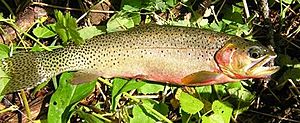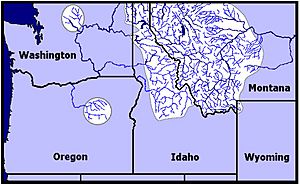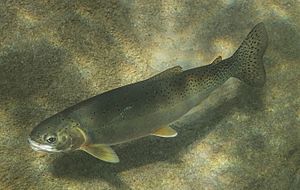Westslope cutthroat trout facts for kids
Quick facts for kids Westslope cutthroat trout |
|
|---|---|
 |
|
| Westslope cutthroat trout | |
| Scientific classification |
|
| Kingdom: | Animalia |
| Phylum: | Chordata |
| Class: | Actinopterygii |
| Order: | Salmoniformes |
| Family: | Salmonidae |
| Genus: | Oncorhynchus |
| Species: | |
| Subspecies: |
O. c. lewisi
|
| Trinomial name | |
| Oncorhynchus clarkii lewisi (G. Suckley, 1856)
|
|
 |
|
| The historic distribution of westslope cutthroat trout in the United States (modified from Behnke 1992). The large region consists primarily of the upper Columbia River and upper Missouri River basins; some waters in the eastern part of this region may not have been occupied historically (MTFWP, in litt. 1998). Also shown are the Lake Chelan and Methow River drainages in Washington and the John Day River drainage in Oregon. | |
| Synonyms | |
|
|
The westslope cutthroat trout (Oncorhynchus clarkii lewisi) is a type of cutthroat trout. It's also known as the black-spotted trout or red-throated trout. This fish lives in freshwater and belongs to the salmon family, called Salmonidae.
The cutthroat trout is the official state fish of Montana. Sadly, this special fish is a "species of concern" in Montana and British Columbia. It's even considered "threatened" in its natural home in Alberta. This means it needs help to survive and thrive.
Contents
About the Westslope Cutthroat Trout's Name
The scientific name for the westslope cutthroat trout is Oncorhynchus clarkii lewisi. It got its name from the famous explorers Meriwether Lewis and William Clark. They found these fish during their big journey, the Lewis and Clark Expedition (1804–1806).
In 1853, a scientist named George Suckley found more of these trout. He named them Salar lewisi to honor Meriwether Lewis. Later, in 1898, other scientists changed the name to Salmo clarki. This was to honor William Clark.
For a while, the name Salmo clarki lewisi was used for both the westslope cutthroat and another fish called the Yellowstone cutthroat trout. But in 1971, a fish expert named Robert J. Behnke gave the Yellowstone cutthroat its own name. This made sure the name Salmo clarki lewisi was only for the westslope cutthroat trout.
In 1989, scientists studied the fish's bodies and genes. They found that trout from the Pacific Ocean were more like Pacific salmon than other trout from the Atlantic Ocean. Because of this, the westslope cutthroat trout, along with rainbow trout, were moved into a new group called Oncorhynchus.
What Does a Westslope Cutthroat Trout Look Like?
This fish has small teeth under its tongue and on the roof of its mouth. Westslope cutthroat trout live in both lakes and streams. They mostly eat insects and tiny water creatures called zooplankton.
Most of these fish are about 8 to 12 inches (20 to 30 cm) long. They rarely grow longer than 18 inches (46 cm). Their skin has small, dark, freckle-like spots. These spots are usually grouped near their tail. The fish often has an orange color.
You can tell them apart from rainbow trout by a special mark. They have a red, pink, or orange mark under their jaw. This mark is why they are called "cutthroat" trout!
Where Do Westslope Cutthroat Trout Live?
Westslope cutthroat trout naturally live in certain parts of North America. You can find them in northern Idaho and British Columbia. They live in the upper Columbia River system and some northern parts of the Snake River.
East of the Continental Divide, they live in Alberta and Montana. They are found in the upper Missouri River, Milk River, and North Saskatchewan rivers.
In Montana, they used to live further east and south. Some small groups of westslope cutthroat trout also live in Oregon and Washington. They are found in the John Day River and rivers along the eastern side of the Cascade Range. Sadly, pure westslope cutthroat trout now live in less than three percent of the areas they used to call home.
Life Cycle of the Westslope Cutthroat Trout
Westslope cutthroat trout have three main ways of living their lives:
- Adfluvial fish: These fish live in big lakes. When it's time to lay their eggs (spawn), they swim into smaller rivers that flow into those lakes.
- Fluvial fish: These fish live in medium to large rivers. They also travel to smaller rivers to spawn. Most adult fish go back to the main river or lake after they have spawned.
- Stream resident fish: These fish spend their whole lives in smaller streams. They don't travel to bigger lakes or rivers.
All three of these life strategies can be found in most areas where the fish live.
Protecting the Westslope Cutthroat Trout
Pure westslope cutthroat trout have disappeared from most of their original homes. This happened because their homes were destroyed and new fish species were brought in. The remaining groups of pure fish live in isolated streams. These streams are usually above natural barriers like waterfalls, which stop other fish from getting in.
When rainbow trout and brown trout were brought into the Missouri River, they replaced the westslope cutthroat trout in many areas. Also, introducing fish like kokanee salmon, lake trout, and lake whitefish into places like Flathead Lake caused the westslope cutthroat trout numbers to drop a lot.
Today, the remaining westslope cutthroat trout are in danger. This is due to human activities like logging, building roads, and mining. They also face problems from mixing with introduced rainbow trout, which creates "cutbows" (a mix of cutthroat and rainbow trout). Even in places like Glacier National Park, their numbers are going down.
The main reasons for their decline include:
- Loss of their natural homes due to logging, road building, and other human developments.
- New types of fish being introduced from hatcheries.
- Competition and mixing with fish species that are not native to the area.


